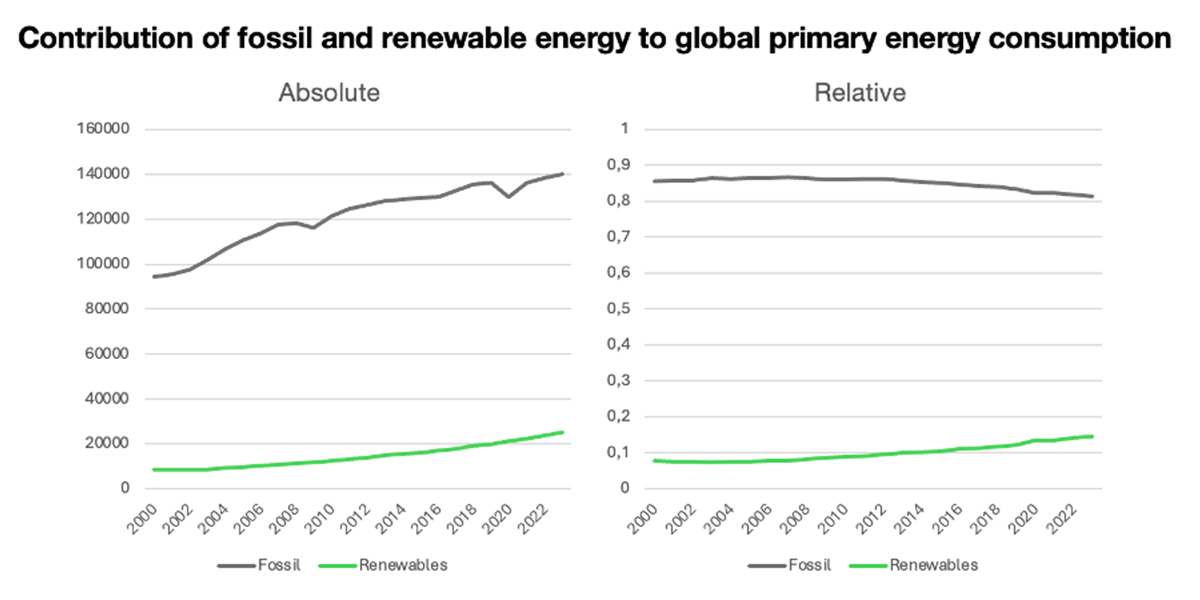Luca Campion graduated with great distinction in June 2019 with a Master's degree in Business Engineering from Hasselt University, specializing in Technology in Business. During his master's studies, he gained valuable consultancy experience through an internship. After graduating, he remained affiliated with Hasselt University, working as a doctoral researcher in the Environmental Economics research group. In both his master's thesis and his doctoral research, Luca focused on integrating techno-economic and life cycle analysis, particularly in the context of biochar, a biobased technology for carbon dioxide removal. In February 2024, Luca joined the strategic team at Econopolis as a Climate Consultant.
Global energy emissions hit record high, despite significant shift towards renewables

Renewables on the rise
Global investment in clean energy technology and infrastructure is projected to reach $2 trillion in 2024, doubling the amount allocated to fossil fuels, according to a report by the International Energy Agency (IEA)[1]. This means that for every dollar invested in fossil fuels today, almost two dollars are invested in clean energy technology. This surge in investment includes renewables, electric vehicles, nuclear power, grids, storage, low-emissions fuels, efficiency improvements, and heat pumps. The driving forces behind this surge include strong economic incentives, continuous cost reductions, and energy security considerations.
The year 2023 marked a record high in renewable energy generation, driven by substantial increases in wind and solar capacity, which saw a 67% rise in new installations compared to 2022. China led the charge, contributing slightly more than half of all renewable generation additions worldwide. Solar energy has become particularly crucial, with investments expected to reach $500 billion in 2024 due to decreasing solar module prices. Looking at the global primary energy consumption[2], renewables now account for 15%, up from 14% in 2022 (25,000 TWh in 2023, compared to 24,000 TWh in 2022)[3].
Insufficiency of renewables to meet increasing energy demand
Even though the share of renewables in primary energy consumption increased, so did the global primary energy demand. It rose to 172,000 TWh in 2023 from 169,000 TWh in 2022. In absolute terms, this 2% increase represents 3,000 TWh, which corresponds to the primary energy demand of a country such as Germany. Because the increase in renewables only amounted to 1,000 TWh, two-thirds of the increased demand was met by fossil fuels (and nuclear energy to a smaller extent). Indeed, fossil fuel use rose by 1.5%, although its share in the primary energy mix decreased slightly to 81.5%.
This increase in fossil fuel consumption led to a record high in global energy emissions, surpassing 40 gigatons in 2023. These increased emissions were further enhanced by a reduction in the share of the relatively clean natural gas and an increased share of oil and coal. Europe's fossil fuel share fell below 70% for the first time since the Industrial Revolution, with no increase in fossil fuel use in any European country. European gas demand dropped by 7% because of the shift away from Russian gas. While fossil fuel demand may have peaked in advanced economies, economic development drives fossil growth in emerging economies. Notably, global coal consumption reached a new high, largely driven by China and India.

Conclusions and the way forward
The perspective on the energy transition varies depending on whether we consider relative or absolute numbers. The significant rise in the share of clean energy in the overall energy mix suggests that the transition is well underway. However, as clean energy has not yet fully met the increasing energy demand, some argue that the transition is still in its early stages. This underscores the urgency to intensify efforts to reduce carbon emissions and support the development of low-carbon energy sources. Falling renewable energy prices are crucial for their deployment, but attractive investments require more than low marginal costs. A mix of substantial carbon taxes, long-term subsidies, and market design changes is essential to create a sustainable and profitable clean energy future.
Understanding and addressing the complexities of the energy transition is vital for creating a sustainable future. We invite readers to connect with our team to explore innovative solutions and strategies for reducing carbon emissions and enhancing the deployment of renewable energy. Amongst other things, we built experience in the field by developing a climate roadmap for the Ghent region and the authorship of the book “De Klimaatschok.” Contact us today to learn more!
[1] https://www.iea.org/reports/world-energy-investment-2024
[2] Primary energy consumption measures the total amount of raw energy consumed from sources like fossil fuels, nuclear, and renewables. It includes energy used for electricity generation, as well as energy used directly for heating, transportation, and industrial processes. Furthermore, it accounts for energy losses that occur during the conversion and distribution.
[3] https://www.energyinst.org/statistical-review